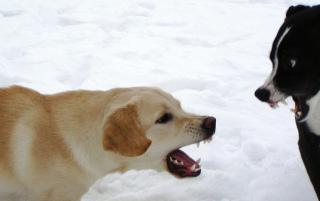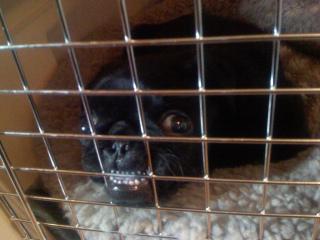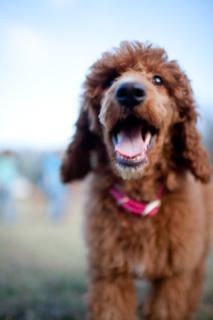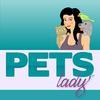Dog aggression is a serious problem, and it's usually the owner that gets hurt. Keep reading to learn how to stop dominant dog behavior at an early age, before it becomes a real problem.

Causes Of Dominant Behavior
Dogs are pack animals. That means they need to look at you as the pack leader. If they don't see you as a pack leader, they'll likely begin to show dominant behavior. Usually dominant behavior is caused by the owner. Failure to train a dog that you are the pack leader (or a previous owner's failure) will teach a dog that he is on equal or higher standing than you are. He won't feel that he has to listen to you, and he may turn protective or aggressive over his things.
Recognize The Signs
If you see any signs of dominant behavior in your pup, it's important to get it taken care of quickly, regardless of if your dog is big or small. Some early signs might include protectiveness over food or toys, growling, or snapping. Be sure not to mix up dominant behavior with standard prey instincts that puppies develop. If a puppy is nipping and playing with your hands or pant leg for instance, it's probably just prey instincts.
Start Young
If possible, it's important to steer your pup away from dominant behavior at a young age, preferably before he even starts showing signs of it. If he does show signs of dominance, start behavior training immediately. Give your pup the proper training before he exhibits any dominant instincts, so he'll recognize you as the pack leader from an early age. After your pup starts acting dominant, he'll become harder to train as he ages.

Know Pack Instincts
If your dog doesn't recognize you as the pack leader, he's going to believe that he's of equal or higher standing than you are. This leads to dominant or aggressive behavior. To a dog and other pack animals, rank within a family "pack" is a big deal. A lower ranking pack member should never challenge a higher ranking pack member for food, bedding, etc. The highest ranking pack member always gets first choice of food and bed.
For this reason, you shouldn't let your dog do anything that will make him believe that he's of higher or equal rank than you are. You should be the one to go through the door first, you should have the first choice of food, and you should be the only one that gets to sleep on the bed and sit on the furniture. If your dog growls at you, other members of the family, or visitors, he may believe that he's a higher ranking pack member.
Don't Give Your Dog Human Privileges
It's your responsibility to make it clear to your dog that he's a lower ranking pack member than you are. To enforce this, you must never give your dog any human privileges. What this means is:
- You should never feed your dog from the table.
- You should eat before your dog does.
- You shouldn't allow your dog in the same room while you're eating.
- You should never let your dog on the furniture.
- You should never let your dog sleep on your bed.
- At first, your dog shouldn't even be allowed to sleep in your room outside of a crate.
You're The Pack Leader
At a young age, your pup will naturally assume a position among your family pack. You'll need to make it clear that you're the pack leader. This will make it so he believes that you're that pack leader while he's still young, before he starts asserting any dominant behavior. A good way to assume a pack leader position is to observe how a pack of wolves operates. When an alpha wolf wants something done, none of the other wolves challenge him. They just do it. The alpha wolf maintains control with subtle body language and orders. He always gets his first choice of food and sleeping area. It doesn't take long for a dog to decide who's the most dominant in the family pack, so it's important to establish rankings while the puppy is still young with strict and thorough obedience training.
Make Your Dog Work
Whenever you give your dog something it's important to make him work for it. For instance, if you're feeding him, you should make him sit and stay first. Only give him the food after he obeys. Follow similar procedures when you're giving your dog a toy or a treat. He always needs to earn it, even if you're just petting him.

Neutered Or Spayed
Neutering or spaying a dog at an early age can help eliminate a lot of dominant behaviors. It reduces the chance of some cancers, and lowers hormones that can contribute to dominant aggression.
Training Collar Or Short Leash
While you're training your dog non-dominant behavior, he should always have a good leash like Premier ECO Dog Leash and a good training collar like StarMark Training Collar, especially if he's an older dog just learning non-dominant behavior. These should always be on when he's free around the house. When he's not wearing them, he should be kept in a kennel. Never put these on him while he's unattended. This will have to continue until the dominant behavior subsides and the dog has recognized you as the pack leader.
No Tug-Of-War
Tug-of-war and rough housing only encourages dominant behavior. It's best to avoid this kind of play completely.
Food And Toy Dominance
If your dog is acting dominant over his food, toys, or bed, it's important to let him know that he has no right to. He needs to know that you control the world around him. Start at a young age for the best results. Your dog needs to learn that he has to work for his food and toys.
Begin by making your pup sit and stay before you give him his food. While he's eating, stay around the pup and gently stroke his fur. Don't take the bowl away from him or make any sudden movements. Keep your hand near the bowl. This will let the pup know that your presence around his food isn't a bad thing. If you're dealing with an older dog, don't stay around him while he's eating as you may be putting yourself in danger. Instead, give him his food inside of a crate.
He should work for toys as well. Make him obey a command before you reward him with a toy. If he acts possessive over the toy, take it away. If the dog is acting too aggressive, you can wait for him to drop it. Don't give him the toy at all for at least a few days. Try to reward him with the toy again, and if he acts possessive, take it away again. He has to know that you're in control of his toys.
These tips should help you to teach your pup non-dominant behavior. If you're dealing with an older dog, it's probably a good idea to hire a behavior specialist to lower any risk of getting hurt.
Also Read: Signs Of Aggressive Behavior In Dogs

